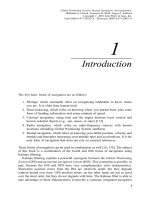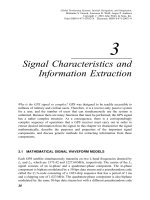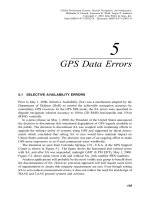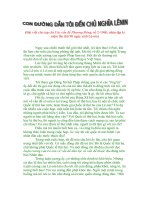Tài liệu GPS - đường dẫn quán tính và hội nhập P7 pdf
Bạn đang xem bản rút gọn của tài liệu. Xem và tải ngay bản đầy đủ của tài liệu tại đây (460.37 KB, 50 trang )
7
Kalman Filter Basics
7.1 INTRODUCTION
7.1.1 What is a Kalman Filter?
It is an extremely effective and versatile procedure for combining noisy sensor
outputs to estimate the state of a system with uncertain dynamics.
For our purposes in this book:
The noisy sensors may include GPS receivers and inertial sensors (acceler-
ometers and gyroscopes, typically)but may also include speed sensors (e.g.,
wheel speeds of land vehicles, water speed sensors for ships, air speed sensors
for aircraft, or Doppler radar), and time sensors (clocks).
The system state in question may include the position, velocity, acceleration,
attitude,andattitude rate of a vehicle on land, at sea, in the air, or in space, but
the system state may include ancillary ``nuisance variables'' for modeling
correlated noise sources (e.g., GPS Selective Availability timing errors)and
time-varying parameters of the sensors, such as scale factor, output bias, or (for
clocks)frequency. Selective Availability has been suspended as of May 1,
2000.
Uncertain dynamics includes unpredictable disturbances of the host vehicle,
whether caused by a human operator or by the medium (e.g., winds, surface
currents, turns in the road, or terrain changes), but it may also include
unpredictable changes in the sensor parameters.
179
Global Positioning Systems, Inertial Navigation, and Integration,
Mohinder S. Grewal, Lawrence R. Weill, Angus P. Andrews
Copyright # 2001 John Wiley & Sons, Inc.
Print ISBN 0-471-35032-X Electronic ISBN 0-471-20071-9
More abstract treatments of the Kalman ®lter are presented in [18, 19, 40, 46, 67, 69,
71, 72], and a more basic introduction can be found in [31].
7.1.2 How it Works
The Kalman ®lter maintains two types of variables:
1. Estimated State Vector. The components of the estimated state vector include
the following:
(a)The variables of interest (i.e., what we want or need to know, such as
position and velocity).
(b)``Nuisance variables'' that are of no intrinsic interest but may be necessary
to the estimation process. These nuisance variables may include, for
example, the selective availability errors of the GPS satellites. We
generally do not wish to know their values but may be obliged to calculate
them to improve the receiver estimate of position.
(c)The Kalman ®lter state variables for a speci®c application must include all
those system dynamic variables that are measurable by the sensors used in
that application. For example, a Kalman ®lter for a system containing
accelerometers and rate gyroscopes must contain acceleration and rotation
rate components to which these instruments respond. The acceleration and
angular rate components do not have to be those along the sensor input
axes, however. The Kalman ®lter state variables could be the components
along locally level earth-®xed coordinates, even though the sensors
measure components in vehicle-body-®xed coordinates.
In similar fashion, the Kalman ®lter state variables for GPS-only navigation
must contain the position coordinates of the receiver antenna, but these could
be geodetic latitude, longitude, and altitude with respect to a reference
ellipsoid or geocentric latitude, longitude, and altitude with respect to a
reference sphere, or ECEF Cartesian coordinates, or ECI coordinates, or any
equivalent coordinates.
2. A Covariance Matrix: a Measure of Estimation Uncertainty. The equations
used to propagate the covariance matrix (collectively called the Riccati
equation)model and manage uncertainty, taking into account how sensor
noise and dynamic uncertainty contribute to uncertainty about the estimated
system state.
By maintaining an estimate of its own estimation uncertainty and the relative
uncertainty in the various sensor outputs, the Kalman ®lter is able to combine all
sensor information ``optimally,'' in the sense that the resulting estimate minimizes
any quadratic loss function of estimation error, including the mean-squared value of
any linear combination of state estimation errors. The Kalman gain is the optimal
180
KALMAN FILTER BASICS
weighting matrix for combining new sensor data with a prior estimate to obtain a
new estimate.
7.2 STATE AND COVARIANCE CORRECTION
The Kalman ®lter is a two-step process, the steps of which we call ``prediction'' and
``correction.'' The ®lter can start with either step, but we will begin by describing the
correction step ®rst.
The correction step makes corrections to an estimate, based on new information
obtained from sensor measurements.
The Kalman gain matrix
K is the crown jewel of Kalman ®ltering. All the effort
of solving the matrix Riccati equation is for the sole purpose of computing the
``optimal'' value of the gain matrix
K used for correcting an estimate
^
x,
^
x
|{z}
corrected
^
xÀ
|{z}
predicted
K
gain
|{z}
z
|{z}
meas:
À H
^
xÀ
|{z}
pred: meas:
P
R
Q
S
; 7:1
based on a measurement
z Hx noise 7:2
that is a linear function of the vector variable x to be estimated plus additive noise
with known statistical properties.
We will derive a formula for the Kalman gain based on an analogous ®lter called
the Gaussian maximum-likelihood estimator. It uses the analogies shown in Table
7.1 between concepts in Kalman ®ltering, Gaussian probability distributions, and
likelihood functions.
The derivation begins with background on properties of Gaussian probability
distributions and Gaussian likelihood functions, then development of models for
noisy sensor outputs and a derivation of the associated maximum-likelihood estimate
(MLE)for combining prior estimates with noisy sensor measurements.
7.2.1 Gaussian Probability Density Functions
Probability density functions (PDFs)are nonnegative integrable functions whose
integral equals unity (i.e., 1). The density functions of Gaussian probability
distributions all have the form
px
1
2p
n
det P
p
expÀ
1
2
x À m
T
P
À1
x À m; 7:3
7.2 STATE AND COVARIANCE CORRECTION
181
where n is the dimension of P (i.e., P is an n  n matrix)and the parameters
m
def
E
xPx m;P
hxi7:4
def
x
1
dx
1
ÁÁÁ
x
1
dx
n
pxx; 7:5
P
def
E
xPx m;P
hx À mx À m
T
i7:6
def
x
1
dx
1
ÁÁÁ
x
1
dx
n
pxx À mx À m
T
: 7:7
The parameter m is the mean of the distribution. It will be a column vector with
the same dimensions as the variate x.
The parameter P is the covariance matrix of the distribution. By its de®nition, it
will always be an n  n symmetric and nonnegative de®nite matrix. However,
because its determinant appears in the denominator of the square root and its
inverse appears in the exponential function argument, it must be positive de®nite as
well. That is, its eigenvalues must be real and positive for the de®nition to work.
The constant factor 1=
2p
n
det P
p
in Eq. 7.3 is there to make the integral of the
probability density function equal to unity, a necessary condition for all probability
density functions.
The operator EhÁi is the expectancy operator, also called the expected-value
operator.
The notation x Pxm; P denotes that the variate (i.e., random variable) x is
drawn from the Gaussian distribution with mean m and covariance P. Gaussian
distributions are also called normal or Laplace distributions.
TABLE 7.1 Analogous Concepts in Three Different Contexts
Context Kalman
®ltering
6 Gaussian
probability
distributions
6 Maximum-
likelihood
estimation
Concepts Probability
distribution
6 Likelihood
function v
Estimate 6 Mean 6 argmax(v
a
Covariance 6 Covariance 6 Information
a
Argmax(f ) returns the argument x of the function f where fx achieves its maximum value.
For example, argmax(sin) p=2 and argmax(cos) 0.
182
KALMAN FILTER BASICS
7.2.2 Likelihood Functions
Likelihood functions are similar to probability density functions, except that their
integrals are not constrained to equal unity, or even required to be ®nite. They are
useful for comparing relative likelihoods and for ®nding the value of the unknown
independent variable x at which the likelihood function achieves its maximum, as
illustrated in Fig. 7.1.
7.2.2.1 Gaussian Likelihood Functions Gaussian likelihood functions
have the form
vx; m; YexpÀ
1
2
x À m
T
Yx À m; 7:8
where the parameter Y is called the information matrix of the likelihood function. It
replaces P
À1
in the Gaussian probability density function. If the information matrix
Y is nonsingular, then its inverse Y
À1
P, a covariance matrix. However, an
information matrix is not required to be nonsingular. This property of information
matrices is important for representing the information from a set of measurements
(sensor outputs)with incomplete information for determining the unknown vector x.
That is, the measurements may provide no information about some linear combina-
tions of the components of x, as illustrated in Fig. 7.2.
7.2.2.2 Scaling of Likelihood Functions Maximum-likelihood estimation
is based on the argmax of the likelihood function, but for any positive scalar c > 0,
argmaxcv argmaxv: 7:9
Fig. 7.1 Maximum-likelihoodestimate.
7.2 STATE AND COVARIANCE CORRECTION
183
That is, positive scaling of likelihood functions will have no effect on the maximum-
likelihood estimate. As a consequence, likelihood functions can have arbitrary
positive scaling.
7.2.2.3 Independent Likelihood Functions The joint probability PAB
of independent events A and B is the product PA&BPAÂPB. The
analogous effect on independent likelihood functions v
A
and v
B
is the pointwise
product. That is, at each ``point'' x,
v
AB
xv
A
xÂv
B
x: 7:10
7.2.2.4 Pointwise Products One of the remarkable attributes of Gaussian
likelihood functions is that their pointwise products are also Gaussian likelihood
functions, as illustrated in Fig. 7.3.
Given two Gaussian likelihood functions with parameter sets m
A
; Y
A
ÈÉ
and
fm
B
; Y
B
g, their pointwise product is a scaled Gaussian likelihood function with
parameters fm
AB
; Y
AB
g such that, for all x,
expÀ
1
2
x À m
AB
T
Y
AB
x À m
AB
c expÀ
1
2
x À m
A
T
Y
A
x À m
A
 exp 1
2
x À m
B
T
Y
B
x À m
B
7:11
for some constant c > 0.
&
&
&&
&
&&
Fig. 7.2 Likelihoodwithout maximum.
184
KALMAN FILTER BASICS
One can solve Eq. 7.11 for the parameters fm
AB
; Y
AB
g as functions of the
parameters fm
A
; Y
A
; m
B
; Y
B
g: Taking logarithms of both sides of Eq. 7.11 will
produce the equation
À
1
2
x À m
AB
T
Y
AB
x À m
AB
logcÀ
1
2
x À m
A
T
Y
A
x À m
A
À
1
2
x À m
B
T
Y
B
x À m
B
: 7:12
Next, taking the ®rst and second derivatives with respect to the independent variable
x will produce the equations
Y
AB
x À m
AB
Y
A
x À m
A
Y
B
x À m
B
; 7:13
Y
AB
Y
A
Y
B
; 7:14
respectively.
Information is Additive The information matrix of the combined likelihood
function (Y
AB
in Eq. 7.14)equals the sum of the individual information matrices
of the component likelihood functions (Y
A
and Y
B
in Eq. 7.14).
CombinedMaximum-LikelihoodEstimate is a WeightedAverage Equation
7.13 evaluated at x 0is
Y
AB
m
AB
Y
A
m
A
Y
B
m
B
; 7:15
&&
&& &
&&
&
&
&&
Fig. 7.3 Pointwise products of Gaussian likelihood functions.
7.2 STATE AND COVARIANCE CORRECTION
185
which can be solved for
m
AB
Y
y
AB
Y
A
m
A
Y
B
m
B
7:16
Y
A
Y
B
y
Y
A
m
A
Y
B
m
B
; 7:17
where y denotes the Moore±Penrose inverse of a matrix (de®ned in Section B.1.4.7).
Equations 7.14 and 7.17 are key results for deriving the formula for Kalman gain.
All that remains is to de®ne likelihood function parameters for noisy sensors.
7.2.3 Noisy Measurement Likelihoods
The term measurements refers to outputs of sensors that are to be used in estimating
the argument vector x of a likelihood function. Measurement models represent how
these measurements are related to x, including those errors called measurement
errors or sensor noise. These models can be expressed in terms of likelihood
functions with x as the argument.
7.2.3.1 Measurement Vector The collective output values from a multitude `
of sensors are the components of a vector
z
def
z
1
z
2
z
3
.
.
.
z
`
P
T
T
T
T
T
R
Q
U
U
U
U
U
S
; 7:18
called the measurement vector, a column vector with ` rows.
7.2.3.2 Measurement Sensitivity Matrix We suppose that the measured
values z
i
are linearly
1
related to the unknown vector x we wish to estimate,
z Hx 7:19
where H is the measurement sensitivity matrix.
7.2.3.3 Measurement Noise Measurement noise is the electronic noise at the
output of the sensors. It is assumed to be additive,
z Hx v; 7:20
&&
1
The Kalman ®lter is de®ned in terms of the measurement sensitivity matrix H, but the extended Kalman
®lter (described in Section 7.6.4)can be de®ned in terms of a suitably differentiable vector-valued function
hx.
186
KALMAN FILTER BASICS
where the measurement noise vector v is assumed to be zero-mean Gaussian noise
with known covariance R,
Ehvi
def
0; 7:21
R
def
Ehvv
T
i: 7:22
7.2.3.4 Measurement Likelihood A measurement vector z and its associated
covariance matrix of measurement noise R de®ne a likelihood function for the
``true'' value of the measurement (i.e., without noise). This likelihood function will
have mean
m
z
z
and information matrix
Y
z
R
À1
;
assuming R is nonsingular.
7.2.3.5 Unknown Vector Likelihoods The same parameters de®ning
measurement likelihoods also de®ne an inferred likelihood function for the true
value of the unknown vector, with mean
m
x
H
y
m
z
7:23
H
y
z 7:24
and information matrix
Y
x
H
T
Y
z
H 7:25
H
T
R
À1
H; 7:26
where the n  ` matrix H
y
is de®ned as the Moore±Penrose generalized inverse
(de®ned in Appendix B)of the ` Â n matrix H. This information matrix will be
singular if `<n (i.e., there are fewer sensor outputs than unknown variables), which
is not unusual for GPS=INS integration.
7.2.4 Gaussian MLE
7.2.4.1 Variables Gaussian MLE uses the following variables:
^
x, the maximum likelihood estimate of x. It will always equal the argmax (mean
m)of an associated Gaussian likelihood function, but it can have different
values:
7.2 STATE AND COVARIANCE CORRECTION
187
^
xÀ, representing the likelihood function prior to using the measurements.
^
x, representing the likelihood function after using the measurements.
P, the covariance matrix of estimation uncertainty. It will always equal the inverse
of the information matrix Y of the associated likelihood function. It also can
have two values:
PÀ, representing the likelihood function prior to using the measurements.
P, representing the likelihood function after using the measurements.
z, the vector of measurements.
H, the measurement sensitivity matrix.
R, the covariance matrix of sensor noise.
7.2.4.2 Update Equations The MLE formula for updating the variables
^
x and
P to re¯ect the effect of measurements can be derived from Eqs. 7.14 and 7.17 with
initial likelihood parameters
m
A
^
xÀ; 7:27
the MLE before measurements, and
Y
A
PÀ
À1
; 7:28
the inverse of the covariance matrix of MLE uncertainty before measurements. The
likelihood function of x inferred from the measurements alone (i.e., without taking
into account the prior estimate)is represented by the likelihood function parameters
Y
B
H
T
R
À1
H; 7:29
the information matrix of the measurements, and
m
B
H
y
z; 7:30
where z is the measurement vector.
7.2.4.3 Covariance Update The Gaussian likelihood function with param-
eters fm
AB
; Y
AB
g of Eqs. 7.14 and 7.17 then represents the state of knowledge
about the unknown vector x combining both sources (i.e., the prior likelihood and
the effect of the measurements). That is, the covariance of MLE uncertainty after
using the measurements will be
P Y
À1
AB
; 7:31
and the MLE of x after using the measurements will then be
^
x m
AB
: 7:32
Equation 7.14 can be simpli®ed by applying the following general matrix formula
2
:
A
À1
BC
À1
D
À1
A À ABC DAB
À1
DA; 7:33
&&
&
&
2
A formula with many discoverers. Henderson and Searle [53] list some earlier ones.
188
KALMAN FILTER BASICS
where
A
À1
Y
A
, the prior information matrix for
^
x
A PÀ, the prior covariance matrix for
^
x
B H
T
, the transpose of the measurement sensitivity matrix
C R
D H, the measurement sensitivity matrix,
so that Eq. 7.31 becomes
P Y
À1
AB
7:34
Y
A
H
T
R
À1
H
À1
Eq:7:147:35
Y
À1
A
À Y
À1
A
H
T
HY
À1
A
H
T
R
À1
HY
À1
A
Eq:7:337:36
PÀ À PÀH
T
HPÀH
T
R
À1
HPÀ; 7:37
a form better conditioned for computation.
7.2.4.4 Estimate Update Equation 7.17 with substitutions from Eqs. 7.27±
7.30 will have the form shown in Eq. 7.37
^
x m
AB
Eq: 7:327:38
Y
A
Y
B
y
Y
A
m
A
Y
B
m
B
Eq: 17:77:39
P
|{z}
Eq: 7:31
PÀ
À1
|{z}
Eq: 7:28
^
xÀ
|{z}
Eq: 7:27
H
T
R
À1
H
|{z}
Eq: 7:29
H
y
z
|{z}
Eq: 7:30
P
R
Q
S
7:40
PÀ À PÀH
T
HPÀH
T
R
À1
HPÀ Eq:7:37
ÂPÀ
À1
^
xÀ H
T
R
À1
HH
y
z7:41
IÀ À PÀH
T
HPÀH
T
R
À1
H
Â
^
xÀ PÀH
T
R
À1
HH
y
z7:42
^
xÀ PÀH
T
HPÀH
T
R
À1
ÂHPÀH
T
RR
À1
À HPÀH
T
R
À1
z À H
^
xÀ
ÈÉ
7:43
^
xÀ PÀH
T
HPÀH
T
R
À1
ÂHPÀH
T
R
À1
I À HPÀH
T
R
À1
z À H
^
xÀ
ÈÉ
7:44
^
xÀ PÀH
T
HPÀH
T
R
À1
|{z}
K
 z À H
^
xÀ
ÈÉ
; 7:45
where the matrix
K has a special meaning in Kalman ®ltering.
&
&
7.2 STATE AND COVARIANCE CORRECTION
189
7.2.5 Kalman Gain Matrix
Equation 7.45 has the form of Eq. 7.1 with Kalman gain matrix
K PÀH
T
HPÀH
T
R
À1
; 7:46
which can be substituted into Eq. 7.37 to yield a simpli®ed update equation for the
covariance matrix update for the effects of using measurements:
P PÀ À
KHPÀ: 7:47
This completes the derivation of the Kalman gain matrix based on Gaussian
MLE.
7.3 STATE AND COVARIANCE PREDICTION
The rest of the Kalman ®lter is the prediction step, in which the estimate
^
x and its
associated covariance matrix of estimation uncertainty P are propagated from one
time epoch to another. This is the part where the dynamics of the underlying physical
processes come into play. The ``state'' of a dynamic process is a vector of variables
that completely specify enough of the initial boundary value conditions for
propagating the trajectory of the dynamic process forward in time, and the procedure
for propagating that solution forward in time is called ``state prediction.'' The model
for propagating the covariance matrix of estimation uncertainty is derived from the
model used for propagating the state vector.
7.3.1 State Prediction Models
7.3.1.1 Differential Equation Models Ever since the differential calculus
was introduced (more or less simultaneously)by Sir Isaac Newton (1643±1727)and
Gottfried Wilhelm Leibnitz (1646±1716), we have been using ordinary differential
equations as models for the dynamical behavior of systems of all sorts.
Example 7.1 Differential Equation Model for Harmonic Resonator. Dynamical
behavior of the one-dimensional damped mass±spring shown schematically in Fig.
7.4 is modeled by the equations
m
d
2
x
dt
2
ma F ÀC
damping
dx
dt
|{z}
damping force
À C
spring
x
|{z}
spring force
wt
|{z}
disturbance
190
KALMAN FILTER BASICS
or
d
2
x
dt
2
C
damping
m
dx
dt
C
spring
m
x
wt
m
; 7:48
where m mass attached to spring and damper
x upward displacement of mass from its rest position
C
spring
spring constant of spring
C
damping
damping coef®cient of dashpot
wtdisturbing force acting on mass
Systems of First-Order Linear Differential Equations The so-called state
space models for dynamic systems replace higher order differential equations with
systems of ®rst-order differential equations. This can be done by de®ning the ®rst
n À 1 derivatives of an nth-order differential equation as state variables.
Example 7.2 State Space Model for Harmonic Oscillator. Equation 7.48 is a
linear second-order n 2 differential equation. It can be transformed into a system
of two linear ®rst-order differential equations with state variables
x
1
def
x mass displacement; x
2
def
dx
dt
mass velocity;
Fig. 7.4 Schematic model for dynamic system of Example 7.1.
7.3 STATE AND COVARIANCE PREDICTION
191
for which
dx
1
dt
x
2
7:49
dx
2
dt
ÀC
spring
m
x
1
ÀC
damping
m
x
2
wt
m
: 7:50
Representation in Terms of Vectors andMatrices State space models using
systems of linear ®rst-order differential equations can be represented more
compactly in terms of a state vector, dynamic coef®cient matrix, and dynamic
disturbance vector.
Systems of linear ®rst-order differential equations represented in ``long-hand''
form as
dx
1
dt
f
11
x
1
f
12
x
2
f
13
x
3
ÁÁÁf
1n
x
n
w
1
;
dx
2
dt
f
21
x
1
f
22
x
2
f
23
x
3
ÁÁÁf
2n
x
n
w
2
;
dx
3
dt
f
31
x
1
f
32
x
2
f
33
x
3
ÁÁÁf
3n
x
n
w
3
;
.
.
.
dx
n
dt
f
n1
x
1
f
n2
x
2
f
n3
x
3
ÁÁÁf
nn
x
n
w
n
can be represented more compactly in matrix form as
d
dt
x Fx w; 7:51
where the state vector x, dynamic coef®cient matrix F, and dynamic disturbance
vector w are given as
x
x
1
x
2
x
3
.
.
.
x
n
P
T
T
T
T
T
R
Q
U
U
U
U
U
S
; F
f
11
f
12
f
13
ÁÁÁ f
1n
f
21
f
22
f
23
ÁÁÁ f
2n
f
31
f
32
f
33
ÁÁÁ f
3n
.
.
.
.
.
.
.
.
.
.
.
.
.
.
.
f
n1
f
n2
f
n3
ÁÁÁ f
nn
P
T
T
T
T
T
R
Q
U
U
U
U
U
S
; w
w
1
w
2
w
3
.
.
.
w
n
P
T
T
T
T
T
R
Q
U
U
U
U
U
S
;
respectively.
192
KALMAN FILTER BASICS
Example 7.3 Harmonic Resonator Model in Matrix Form. For the system of
linear differential equations 7.49 and 7.50,
x
x
1
x
2
45
; F
01
ÀC
spring
m
ÀC
damping
m
P
R
Q
S
; w
0
w
m
P
R
Q
S
:
Eigenvalues of Dynamic Coef®cient Matrices The coef®cient matrix F of a
system of linear differential equations
_
x Fx w has effective units of reciprocal
time, or frequency (in units of radians per second). It is perhaps then not surprising
that the characteristic values (eigenvalues)of F are the characteristic frequencies of
the dynamic system represented by the differential equations.
The eigenvalues of an n  n matrix F are the roots of its characteristic
polynomial
detlI À F
n
k0
a
n
l
n
: 7:52
The eigenvalues of F have the same interpretation as the poles of the related system
transfer function, in that the dynamic system
_
x Fx w is stable if and only if the
solutions l of detlI À F0 lie in the left half-plane.
Example 7.4 Damping and Resonant Frequency for Underdamped Harmonic
Resonator. For the dynamic coef®cient matrix
F
01
ÀC
spring
m
ÀC
damping
m
P
R
Q
S
in Example 7.3, the eigenvalues of F are the roots of its characteristic polynomial
detlI À Fdet
l À1
C
spring
m
l
C
damping
m
P
R
Q
S
l
2
C
damping
m
l
C
spring
m
;
which are
l À
C
damping
2m
Æ
1
2m
C
2
damping
À 4mC
spring
q
:
If the discriminant
C
2
damping
À 4mC
spring
< 0;
7.3 STATE AND COVARIANCE PREDICTION
193
then the mass±spring system is called underdamped, and its eigenvalues are a
complex conjugate pair
l À
1
t
damping
Æ o
resonant
i
with real part
À
1
t
damping
À
C
damping
2m
and imaginary part
o
resonant
1
2m
4mC
spring
À C
2
damping
q
:
The alternative parameter
t
damping
2m
C
damping
is called the damping time constant of the system, and the other parameter o
resonant
is
the resonant frequency in units of radians per second.
The dynamic coef®cient matrix for the damped harmonic resonator model can
also be expressed in terms of the resonant frequency and damping time constant as
F
harmonic resonator
01
Ào
2
À
1
t
2
À
2
t
P
R
Q
S
: 7:53
So long as the damping coef®cient C
damping
> 0, the eigenvalues of this system
will lie in the left half-plane. In that case, the damped mass±spring system is
guaranteed to be stable.
Matrix Exponential Function The matrix exponential function is de®ned (in
Section B.6.4)as
expM
def
I
k0
1
k!
M
k
7:54
for square matrices M. The result is a square matrix of the same dimension as M.
This function has some useful properties:
1. The matrix N expM is always invertible and N
À1
expÀM.
2. If M is antisymmetric (i.e., its matrix transpose M
T
ÀM), then N expM
is an orthogonal matrix (i.e., its matrix transpose N
T
N
À1
).
194
KALMAN FILTER BASICS
3. The eigenvalues of N expM are the (scalar)exponential functions of the
eigenvalues of M.
4. If Ms is an integrable function of a scalar s, then the derivative
d
dt
t
Ms ds
Mt
t
Ms ds
: 7:55
ForwardSolution in Terms of Matrix Exponential Function The property of
the matrix exponential function shown in Eq. 7.55 can be used to de®ne the forward
solution of Eq. 7.51 as
xtexp
t
t
0
Fs ds
23
xt
0
t
t
0
exp À
s
t
0
Fr dr
23
ws ds
45
; 7:56
where xt
0
is the initial value of the state vector x for t ! t
0
.
Time Invariant Systems If the dynamic coef®cient matrix F of Eq. 7.51 does not
depend on t (time), then the problem is called time invariant. In that case,
t
t
0
F ds t À t
0
F 7:57
and the forward solution
xtexp t À t
0
F
ÂÃ
xt
0
t
t
0
exp Às À t
0
F
ÂÃ
ws ds
@A
: 7:58
7.3.1.2 State Models for Discrete Time Measurements are the outputs of
sensors sampled at discrete times ÁÁÁ < t
kÀ1
< t
k
< t
k1
< ÁÁÁ . The Kalman ®lter
uses these values to estimate the state of the associated dynamic systems at those
discrete times.
If we let ...; x
kÀ1
; x
k
; x
k1
; ... be the corresponding state vector values of a
linear dynamic system at those discrete times, then each of these values can be
determined from the previous value by using Eq. 7.56 in the form
x
k
F
kÀ1
x
kÀ1
w
kÀ1
; 7:59
F
kÀ1
def
exp
t
k
t
kÀ1
Fs ds
23
; 7:60
w
kÀ1
def
F
k
t
k
t
kÀ1
exp À
t
t
kÀ1
Fs ds
23
wt dt: 7:61
7.3 STATE AND COVARIANCE PREDICTION
195
Equation 7.59 is the discrete-time dynamic system model corresponding to the
continuous-time dynamic system model of Eq. 7.51.
The matrix F
kÀ1
(de®ned in Eq. 7.60)in the discrete-time model (Eq. 7.59)is
called a state transition matrix for the dynamic system de®ned by F. Note that F
depends only on F, and not on the dynamic disturbance function wt.
The noise vectors w
k
are the discrete-time analog of the dynamic disturbance
function wt. They depend upon F and w.
Example 7.5 State Transition Matrix for Harmonic Resonator Model. The
underdamped harmonic resonator model of Example 7.4 has no time-dependent
terms in its coef®cient matrix (Eq. 7.53), making it a time-invariant model with state
transition matrix
F expDt F
e
ÀDt=t
coso Dt
sino Dt
ot
sino Dt
o
À
sino Dt
ot
2
1 o
2
t
2
coso DtÀ
sino Dt
ot
P
T
T
R
Q
U
U
S
; 7:62
where o o
resonant
; the resonant frequency
t t
damping
; the damping time constant
Dt discrete-time step.
The eigenvalues of F were shown to be À1=t
damping
Æ io
resonant
, so the eigenva-
lues of F Dt will be ÀDt=t
damping
Æ i Dt o
resonant
and the eigenvalues of F will be
exp À
Dt
t
damping
Æ io
resonant
Dt
23
e
ÀDt=t
coso DtÆi sino Dt:
A discrete-time dynamic system will be stable only if the eigenvalues of F lie inside
the unit circle (i.e., jl
`
j < 1).
7.3.2 Covariance Prediction Models
The word stochastic derives from the Greek expression for aiming at a target,
indicating some degree of uncertainty in the dynamics of the projectile between
launch and impact. That idea has been formalized mathematically as stochastic
systems theory, used here for modeling dynamic processes that are not fully
predictable.
A stochastic process is a model for the evolution over time of a probability
distribution. For Kalman ®ltering, this can be viewed as the probability distribution
of the true state of a dynamic process. When the underlying probability distribution
is Gaussian, the distribution is completely speci®ed by its mean and its covariance.
The mean will be the estimated value of the state vector, and the covariance matrix
represents the mean-squared uncertainty in the estimate. The time update equations
196
KALMAN FILTER BASICS
of the Kalman ®lter propagate the estimated value and its associated mean-squared
uncertainty forward in time.
7.3.2.1 Zero-Mean White Gaussian Noise Processes A zero-mean white
Gaussian noise process in discrete time is a sequence of independent samples
...; w
kÀ1
; w
k
; w
k1
; ... from a normal probability distribution x0; Q
k
with
zero mean and known ®nite covariances Q
k
. In Kalman ®ltering, it is not necessary
(but not unusual)that the covariance of all samples be the same.
Sampling is called independent if the expected values of outer products
Ehw
i
w
T
j
i
0; i T j;
Q
i
; i j;
&
7:63
for all integer indices i and j of the random process.
Zero-mean white Gaussian noise processes are the fundamental random processes
used in Kalman ®ltering. However, it is not necessary that all noise sources in the
modeled sensors and dynamic systems be zero-mean white Gaussian noise
processes. It is only necessary that they can be modeled in terms of such processes
(to be addressed in Section 7.5).
7.3.2.2 Gaussian Linear Stochastic Processes in Discrete Time A
linear stochastic processes model in discrete time has the form
x
k
F
kÀ1
x
kÀ1
w
kÀ1
; 7:64
where w
k
is a zero-mean white Gaussian noise process with known covariances Q
k
and the vector x represents the state of a dynamic system.
This model for ``marginally random'' dynamics is quite useful for representing
physical systems (e.g., land vehicles, seacraft, aircraft)with zero-mean random
disturbances (e.g., wind gusts or sea surface currents). The state transition matrix F
k
represents the known dynamic behavior of the system, and the covariance matrices
Q
k
represent the unknown random disturbances. Together, they model the propaga-
tion of the necessary statistical properties of the state variable x.
Example 7.6 Harmonic Resonator with White Acceleration Disturbance
Noise. If the disturbance acting on the harmonic resonator of Examples 7.1±7.5
were zero-mean white acceleration noise with variance s
2
disturbance
, then its distur-
bance noise covariance matrix would have the form
Q
00
0 s
2
disturbance
!
: 7:65
7.3.2.3 Noise Distribution Matrix A common noise source can disturb more
than one independent component of the state vector representing a dynamic system.
7.3 STATE AND COVARIANCE PREDICTION
197
Forces applied to a rigid body, for example, can affect rotational dynamics as well as
translational dynamics. This sort of coupling of common disturbance noise sources
into different components of the state dynamics can be represented by using a noise
distribution matrix G in the form
d
dt
x Fx Gwt; 7:66
where the components of wt are the common disturbance noise sources and the
matrix G represents how these disturbances are distributed among the state vector
components.
The covariance of state vector disturbance noise will then have the form GQ
w
G
T
,
where Q
w
is the covariance matrix for the white-noise process wt.
The analogous model in discrete time has the form
x
k
F
kÀ1
x
kÀ1
G
kÀ1
w
kÀ1
; 7:67
where fw
k
g is a zero-mean white-noise process in discrete time.
In either case (i.e., continuous or discrete time), it is possible to use the noise
distribution matrix for noise scaling, as well, so that the components of w
k
can be
independent, uncorrelated unit normal variates and the noise covariance matrix
Q
w
I, the identity matrix.
7.3.2.4 Predictor Equations The linear stochastic process model parameters
F and Q can be used to calculate how the discrete-time process variables m and P
evolve over time.
Using Eq. 7.64 and taking expected values,
m
k
def
Ehx
k
i
F
kÀ1
Ehx
kÀ1
iEhw
kÀ1
i
F
kÀ1
m
kÀ1
0
F
kÀ1
m
kÀ1
; 7:68
P
k
def
Ehx
k
À mx
k
À m
k
T
i
F
kÀ1
Ehx
kÀ1
À m
kÀ1
x
kÀ1
À m
kÀ1
T
iF
T
kÀ1
Ehw
kÀ1
w
T
kÀ1
iterms with expected value 0
F
kÀ1
P
kÀ1
F
T
kÀ1
Q
kÀ1
: 7:69
7.4 SUMMARY OF KALMAN FILTER EQUATIONS
7.4.1 Essential Equations
The complete equations for the Kalman ®lter are summarized in Table 7.2.
198
KALMAN FILTER BASICS









